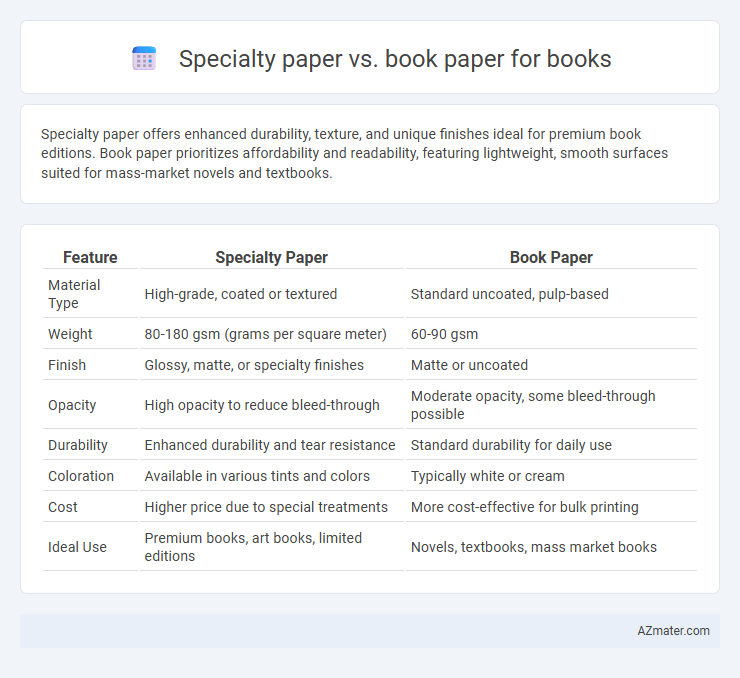Specialty paper offers enhanced durability, texture, and unique finishes ideal for premium book editions. Book paper prioritizes affordability and readability, featuring lightweight, smooth surfaces suited for mass-market novels and textbooks.
Table of Comparison
| Feature | Specialty Paper | Book Paper |
|---|---|---|
| Material Type | High-grade, coated or textured | Standard uncoated, pulp-based |
| Weight | 80-180 gsm (grams per square meter) | 60-90 gsm |
| Finish | Glossy, matte, or specialty finishes | Matte or uncoated |
| Opacity | High opacity to reduce bleed-through | Moderate opacity, some bleed-through possible |
| Durability | Enhanced durability and tear resistance | Standard durability for daily use |
| Coloration | Available in various tints and colors | Typically white or cream |
| Cost | Higher price due to special treatments | More cost-effective for bulk printing |
| Ideal Use | Premium books, art books, limited editions | Novels, textbooks, mass market books |
Introduction to Specialty Paper and Book Paper
Specialty paper is engineered for specific purposes, offering unique textures, weights, and finishes that enhance visual appeal and durability, commonly found in luxury publications and art books. Book paper, designed for mass printing, prioritizes cost-efficiency, readability, and ink absorption, typically featuring a smooth surface and consistent opacity to reduce bleed-through. Choosing between specialty and book paper depends on the desired aesthetic, budget, and functional requirements of the publication.
Defining Specialty Paper: Key Features
Specialty paper for books is characterized by unique attributes such as enhanced texture, durability, and specific finishing treatments like gloss, matte, or embossing that improve aesthetic appeal and tactile experience. It often includes archival-quality materials, acid-free content, or coated surfaces designed to resist aging, discoloration, and wear, making it ideal for limited editions, art books, or high-end publications. Book paper, by contrast, primarily emphasizes readability and cost-effectiveness, featuring standard weight, opacity, and brightness without the additional specialized treatments found in specialty paper.
Understanding Book Paper: Characteristics and Uses
Book paper is designed for durability, featuring a balanced weight between 50-80 gsm and a smooth finish that enhances readability and reduces glare. Specialty paper often includes unique textures or coatings tailored for specific artistic or archival purposes, but may sacrifice the standard opacity and flexibility that book paper provides. Understanding these differences helps in selecting the right paper type to ensure optimal print quality, longevity, and cost-efficiency in publishing.
Comparing Texture and Finish
Specialty paper offers a variety of textures such as linen, felt, or laid, providing a tactile experience that enhances the sensory appeal of high-end or art books, while book paper typically features a smooth or lightly textured finish optimized for readability and efficient ink absorption. Specialty paper finishes can range from matte to glossy, often designed to highlight visual elements and create a distinct aesthetic, whereas book paper usually has a matte or uncoated finish that reduces glare and eye strain for extended reading. Choosing between specialty and book paper depends on the desired tactile quality and visual impact versus practicality and cost-efficiency in publishing.
Durability and Longevity Differences
Specialty paper often features higher cotton or synthetic fiber content, enhancing durability and resistance to wear compared to standard book paper made primarily from wood pulp. Book paper typically has lower acidity and is treated to resist yellowing, but specialty paper excels in longevity due to superior archival qualities and higher basis weight. Choosing specialty paper extends the lifespan of books, making it ideal for rare editions or archival publications where preservation is paramount.
Print Quality: Specialty vs Book Paper
Specialty paper offers enhanced print quality with its smoother surface and higher brightness, resulting in sharper images and more vibrant colors compared to standard book paper. Book paper, designed for cost-effectiveness and readability, typically has a rougher texture and lower brightness that can slightly dull printed details. Choosing specialty paper elevates the visual impact of illustrations and color-rich content, making it ideal for premium or art books, while book paper suits text-heavy publications prioritizing legibility and affordability.
Cost Considerations and Budget Impact
Specialty paper often incurs higher costs due to unique coatings, textures, and durability features essential for premium book editions, impacting overall printing budgets significantly. Book paper, typically more standardized and mass-produced, offers cost-effective solutions conducive to large print runs and tight budget constraints. Choosing between specialty paper and book paper requires balancing desired aesthetic or functional qualities against budget limitations to optimize production expenses.
Environmental and Sustainability Factors
Specialty paper for books often incorporates recycled fibers and sustainable sourcing certifications such as FSC or PEFC, reducing environmental impact compared to traditional book paper made primarily from virgin wood pulp. The manufacturing process of specialty paper typically uses less water and energy, contributing to lower carbon emissions and minimizing deforestation risks. Choosing specialty paper enhances a book's eco-friendly profile by supporting circular economy principles and promoting responsible forest management.
Use Cases: When to Choose Each Paper Type
Specialty paper is ideal for high-end publications requiring enhanced durability, unique textures, or vibrant color reproduction, such as art books, limited editions, or photography books. Book paper is best suited for mass-produced novels, textbooks, and general reading materials where cost-effectiveness, readability, and standard weight are primary considerations. Choosing between specialty and book paper depends on the intended audience, budget constraints, and the desired tactile and visual experience.
Conclusion: Which Paper Is Best for Your Book?
Specialty paper offers unique textures and finishes that enhance the tactile and visual appeal of art books, photography collections, and luxury editions, providing durability and high-quality image reproduction. Book paper, typically more cost-effective and lightweight, is ideal for mass-market novels, textbooks, and general reading material where readability and economy are prioritized. Choosing the best paper depends on the book's purpose, target audience, and budget, with specialty paper suited for premium projects and book paper for standard publishing needs.

Infographic: Specialty paper vs Book paper for Book
 azmater.com
azmater.com